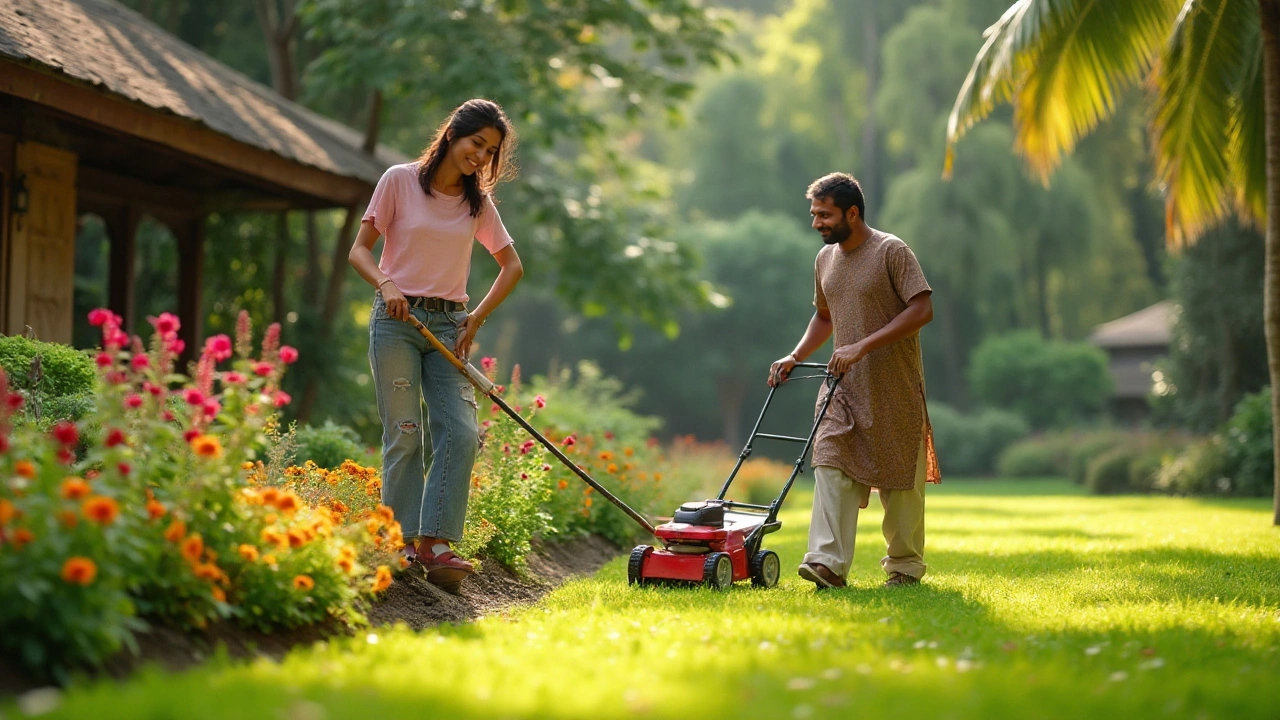Essential Yard Work Tasks for a Well-Maintained Landscape

It's a bright December day, and as I sit with my cup of coffee, I can't help but think about how a well-maintained yard can transform the look and feel of a home. Yard work isn't just about putting in hours with a rake or a mower—it's about nurturing a space where nature and comfort meet. Whether you're new to the game or a seasoned green thumb, knowing the ins and outs of yard work can help you cultivate a yard that's both beautiful and practical.
Yard work encompasses a myriad of tasks that work together to create and maintain an outdoor space. From regular lawn mowing to intricate garden care, each task plays a significant role in keeping your yard vibrant and inviting. Dive into the fascinating aspects of yard care and discover tips and techniques to make your landscape flourish throughout the year.
Lawn Maintenance
There's something irresistibly satisfying about the look of a well-tended lawn. A healthy, lush lawn not only ups your home's curb appeal but also provides a soft, inviting space for family and friends to enjoy. Yet, achieving that perfect stretch of green requires diligent lawn care and regular attention to key maintenance tasks. It involves mowing, watering, fertilization, and a host of other practices aimed at keeping your lawn vibrant and robust throughout the seasons. Let's delve into these critical components and uncover the secrets to creating a thriving lawn.
Mowing is the cornerstone of effective lawn maintenance. As simple as it might seem, mowing requires a strategic approach to truly benefit your grass. It’s essential to keep the mower blades sharp to prevent tearing, which can make your lawn susceptible to diseases. The general rule of thumb is the one-third rule — never cut more than one-third of the grass height at a time. By adhering to this guideline, you’ll ensure your lawn stays healthy and stress-free. Plus, mowing in varied patterns each time encourages upright growth, minimizing matting and helping spread nutrients evenly.
Watering is crucial yet often misunderstood. Overwatering can drown roots and waste precious resources, while underwatering can leave your lawn parched and yellowing. Most lawns require about an inch of water each week, which might vary depending on grass type and climate. It's wise to water deeply and less frequently to encourage roots to grow deeper into the soil. Early morning watering reduces evaporation losses and helps stave off mildew and fungal diseases. Remember, it's like giving your lawn a good drink rather than the occasional sip.
Fertilization is where the magic happens in yard work. A meticulously fertilized lawn flourishes with vibrant color and resilience. Often, lawns need a balanced blend of nitrogen, phosphorus, and potassium to thrive, and soil testing is advisable to tailor this to your yard's specific needs. Regularly scheduled applications in spring and fall, or specific slow-release formulas, can create a steady supply of nutrients, ensuring continued growth and healthy green coloring. Many experts agree, feeding your lawn just before it rains naturally integrates nutrients into the soil, providing maximum nourishment for the grassroots.
To tackle unwanted guests, like weeds, aeration is a lifesaver for compacted lawns. It involves poking holes into the ground, allowing air, water, and nutrients to penetrate deeper. This simple action helps counter soil compaction, which can suffocate roots and stymie growth. Spring and fall are ideal for aeration, ensuring your lawn breathes easy and has room to grow. It's particularly effective for areas that experience heavy footsteps or where thatch, a layer of dead matter, has thickened. By integrating aeration into your routine, you can dramatically improve your lawn's resilience against weeds.
“A well-kept lawn is nature's carpet under your feet, providing a soft, lush space that makes you proud to say 'I've done this myself.'” – John W. Tukey, renowned horticulturist.
Incorporating these practices into your regular yard routine can make a world of difference. Yet, for those who cherish time more than toil, professional landscaping services might offer a solution that balances personal enjoyment with expert care. Whatever path you choose, understanding the fundamental aspects of yard work empowers you to create an outdoor haven that mirrors your commitment and personal style.

Pruning and Trimming
Pruning and trimming are much more than mere tasks—these practices are akin to art forms, essential for maintaining the health and appearance of your yard. It's like giving your garden a proper haircut, ensuring every plant looks its best. Pruning involves selectively removing certain parts of a plant, such as branches, buds, or roots, to improve its shape and health. Trimming is often more about aesthetics, keeping those hedges and shrubs neatly shaped. While the terms may seem interchangeable, they serve distinct purposes. Effective pruning can prevent disease, encourage more robust growth, and even extend the lifespan of your plants. When properly executed, trimming can significantly enhance the look and feel of your entire landscape, fostering a harmonious balance between wild nature and structured beauty.
The timing of these activities is pivotal. Many plants thrive when pruned during their dormant phase, typically in late winter or early spring, before the new growth spurt. This reduces the risk of disease and helps the plant to heal more swiftly. However, flowering shrubs might have their unique cycle, requiring pruning immediately after their bloom cycle to avoid cutting off buds that set for the following season. So, understanding the specific needs of each plant species is crucial. Interestingly, incorrect pruning can have detrimental effects, sometimes stressing or damaging the plant beyond repair. For those a bit unsure about how much to trim, consider the words of horticulturist and author Lisa Eldred Steinkopf:
"The best time to prune is when your pruners are sharp."This underscores the importance of technique and tool readiness in achieving the best results.
Tools are the unsung heroes of effective yard work. With the right shear, you can tackle almost any pruning or trimming task efficiently. Hand pruners, lopping shears, and pruning saws - each has a purpose and requires regular maintenance to ensure precise cuts. A dull blade not only struggles with tough branches but can also harm plants, leaving ragged cuts that invite pests and disease. Taking time to clean and sharpen your tools can save substantial effort and frustration in the long run. Moreover, investing in ergonomic tools can alleviate fatigue and prevent injuries, making tackling large jobs like ornamental tree trimming far more manageable and enjoyable.
The true artistry of pruning and trimming becomes apparent when looking at advanced techniques like topiary and espalier, which often stir creativity in ways typical yard tasks do not. Topiary involves training plants into intricate shapes and animals, while espalier refers to growing trees flat against structures. These techniques add whimsy and unique personality to gardens, transforming ordinary landscapes into living works of art. While advanced methods may seem daunting, mastering the basics of pruning and trimming sets a solid foundation for exploring these more challenging pursuits. In such endeavors, patience is your greatest ally because each cut shapes the eventual masterpiece over time.

Garden Care and Planting
Creating a serene garden sanctuary takes more than just planting a few flowers and calling it a day. It demands attentive garden maintenance, a touch of creativity, and an understanding of seasonal planting cycles. The art of garden care and planting is an ongoing process that involves nurturing your outdoor space so it can burst with color and life in every season. Regular attention to your garden's soil health, water needs, and pest control are essential aspects that help bolster plant growth. Whether you're sowing seeds or installing shrubs, a successful garden becomes a harmonious interplay between the gardener's hand and the rhythm of nature.
Choosing the right plants is a fundamental step in shaping your garden. To create a landscape that is as sustainable as it is aesthetic, consider native plants. These plants are adapted to the local climate, making them more resilient to local weather shifts and pests, reducing the need for excessive water and pesticides. According to the National Wildlife Federation, native plants can reduce maintenance costs by nearly 50% because they require fewer resources to thrive. As you plant, pay attention to the specific needs of each species such as sunlight, soil pH, and water requirements. This consideration ensures a flourishing garden that not only looks great but supports biodiversity.
Paul Tukey, a renowned advocate for organic lawn care, once said, "The best designs begin with observing your landscape for long periods, taking note of what naturally occurs there."
Cultivating a fertile soil environment is critical for any successful garden. Begin by conducting a soil test to understand its composition and nutrient content. Adding organic matter such as compost enriches the soil, improves its structure, and helps retain moisture within the roots. An array of practices from no-till gardening to using mulch can protect soil organisms and promote robust plant growth. As you care for your garden, remember that it is a dynamic ecosystem; maintaining a healthy balance is key to sustainable garden maintenance. By enriching your soil, you're laying a strong foundation for every plant to thrive.
Strategic Planting Techniques
To optimize your planting efforts, consider adopting companion planting techniques. By placing specific plants next to each other, you can naturally repel pests, enhance growth, and elevate the yield of your garden. For example, placing basil near tomatoes can enhance flavor and ward off pests. Another technique, known as succession planting, involves planting new crops in the same area once the previous crop has been harvested. This approach maximizes space and ensures a continuous harvest, an ideal strategy for vegetable gardens. Tender loving care, combined with these savvy practices, can transform your garden into a lush paradise throughout the year.

Seasonal Clean-Up
Each season brings its unique challenges and opportunities for keeping your yard in top shape. Recognizing the significance of a thorough seasonal clean-up is vital for anyone who values a pristine and functioning landscape. This process isn't merely about clearing leaves or debris; it's a comprehensive task that involves a keen understanding of what each season demands. As the year unfolds, adjusting your approach to yard work according to the season ensures that your landscape remains vibrant and healthy, year-round. Initiating seasonal tasks such as leaf removal, branch pruning, and garden bed preparation can significantly impact the health and aesthetics of your garden and lawn. Ignoring these critical transitions might lead to wasted efforts trying to correct issues that could have been managed preemptively.
Winter, for instance, often calls for clearing away any leftover debris from fall to prevent rot and fungal growth in your yard. It's also an excellent time to prune back overgrown branches, giving your trees and shrubs a strong structure to grow from come spring. “Pruning in the dormant season improves plant health and vigor,” states horticulturist Barbara Pleasant. Her words remind us of the importance of timely maintenance when it comes to promoting healthy plant growth. As spring arrives, gardens burst into life, making it an ideal period to plant new seedlings and divide crowded plants. This seasonal cycle continues through summer and fall, with each time of year offering unique tasks.
Keep in mind that landscaping services often tailor their efforts according to seasonal needs. During the burgeoning warmth of spring and the zenith heat of summer, emphasis might shift towards regular watering, mowing, and pest management. Fall demands preparation for the dormant winter months by putting on a few last finishing touches. This might include fertilizing your lawn and planting bulbs for spring blooms. Statistical data suggests that people who engage in regular seasonal clean-up tend to have better-looking gardens and healthier lawns due to the consistent maintenance routine they establish. According to the National Gardening Association, a well-executed seasonal clean-up can enhance a property's curb appeal by as much as 15%, a significant boost for any homeowner looking to impress neighbors or potential buyers.
For those eager to embark on a journey towards a more attractive and resilient outdoor space, consider crafting a seasonal checklist. An organized list can become a gardener's best friend. Here’s a basic outline to get you started:
- Winter: Prune dormant trees and shrubs, clear away fallen leaves, and protect tender plants with mulch.
- Spring: Divide perennials, inspect irrigation systems, and begin sowing seeds for new plants.
- Summer: Regularly water and mow your lawn, inspect plants for pests, and trim hedges.
- Fall: Rake leaves, fertilize the grass, and plant spring-blooming bulbs.
Each task accomplished through the seasonal clean-up not only contributes to the aesthetic vitality of your yard but sets the stage for the next season’s growth and beauty. With dedication to these seasonal nuances, you'll find that your yard becomes an ever-evolving extension of your home—always ready to welcome you and guests with its refreshing splendor.
Write a comment